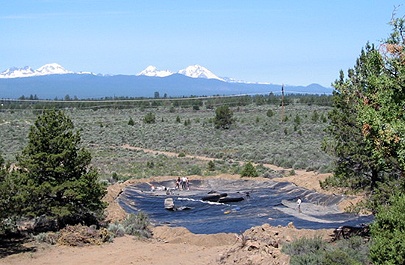Question: I've heard a lot about using algae for fuel. Why is this such a popular topic these days? Answer: Thank you for your question! As concerns over the availability and accessibility of fossil fuels increase, the world is looking for sustainable alternatives. Researchers have explored the use of fuels derived directly from plants such as corn or sugar cane, but those solutions have a number of issues. In an effort to develop a more viable solution, the fuel industry began to use crops designed exclusively for fuel production, such as algae. Many experts now believe that algae represents the cheapest and most environmentally friendly way to produce liquid fuel, which could be used in existing technology such as jet engines or the family car. Currently, the most exciting and innovative algae fuel efforts focus on approaches that couple the production of biofuel with the processing and treatment of other waste, such as sewage, creating a process with a double advantage. In essence, such systems turn the expensive problem of treating contaminated wastewater into a sustainable bioenergy source. Imagine helping fuel a fleet of cars just by flushing your toilet! One key benefit to algae in this instance, is that it can absorb CO2 and pharmaceutical chemicals found in wastewater that cannot be treated by conventional sewage treatment plants. To date, much of the development of biofuels from algae have been on a small scale. Production costs have placed the resulting fuel at a price level that is not competitive with current fossil fuels. However, in February, President Obama announced that the Department of Energy would allocate $14 million in new funding to develop transportation fuels from algae. The DOE is already supporting over 30 such projects. This new funding will push the total investment from the DOE to over $100 million. With the support and interest of the federal government and support from private industry at about $2 billion, several commercial-scale projects are under construction or will break ground this year. This impending boom in production capacity means that algae is set to become a viable source of fuels such as gasoline, jet fuel, diesel and other transportation fuels that can operate safely in existing engines and infrastructure. BTL is working with energy companies to create specialized ponds for growing algae. Our durable, plant safe liners are perfect for such ventures, and present a cost-effective solution to the problem of reliable containment without contamination. We are proud to be involved in cutting edge technology that will potentially establish our energy independence for generations to come in a manner that is also responsive to the needs of environmental protection and global sustainability.
Algae As Biofuel?
AquaArmor Pond Liner
The most versatile liner on the market today, AquaArmor maximizes protection from harmful UV rays, tear resistance and punctures that cause leaks. Simply the best liner on the market.Newest Articles:
Subscribe to Updates
Article Topics
Agriculture
Covers
Tarps
Aquaponics
Energy
Liners
Hydroponics
Greenhouse Light Deprivation
Water Gardens
Farm Ponds
Greenhouses
Greenhouse Gardening
Greenhouse Cover
Fish Pond
Pond
Fish
Golf Course Pond
Golf Course Water Feature
Natural Pond
Landfill Cover
Irrigation
Irrigation Pond
Irrigation Canal
Hydraulic Fracturing
Oil Containment
Secondary Containment
Fracking
Oil Liner
Fuel Liner
Frac Pit
Fire Protection Pond
Fire Suppression Pond
Fire Pond
Geomembrane
Canal Liner
Brine Pond
Koi Pond
Algae Pond
Nursery Pond
Retention Pond
Man-Made Lake
Lakes
Geothermal Greenhouse
Commercial Greenhouse
Preformed Pond Liner
Groundwater Storage Lagoon
Mining Pond
Mining Lagoon
Evaporation Pond
Salt Pond
Pond Liner Materials
Catch Basin
Stormwater Management
Barren Pond
Processing Pond
Natural Swimming Pond
Drainage Systems
Ditch Lining
Aquaculture
Sewage Lagoon
Mining Geomembranes
Floating Cover
Wastewater Containment
Geosynthetics
Cistern Lining
Erosion Control
Fertilizer Containment
Winery Water
Silage Cover
Winery Irrigation Pond
Baseball Field Cover
Tailings Pond
Produced Water Liner
Produced Water Winery
Construction Pond
Winter Ponds
Fish Hatchery
Algae Raceways
Coal Ash Containment
Fishing Lakes
Oilfield Pits
Aquatic Habitats
Lake Restoration
Landfill Cell Liners and Cap Covers
Leachate Pond
Rain Cover
Heap Leach Pads
Residential Ponds
Gas Collection
California Drought
California Pond Liner
Overburden Containment
Pond Liner
Fish Stocking Pond
Mine Reclamation
Wastewater Cover
Drought
Irrigation Reservoir
Sludge Management
Cable Parks
Baffle Systems
Alternative Daily Covers
Reservoir Pond
Aeroponics
Food Shortages
Homesteading
Prepping
Toxic Waste
Potable Water Storage
Green Roof
Clearwells
Stormwater Harvesting
Snow Making Ponds
Pond Plants
Hunting Ponds
Oregon Pond Liner
Lavender
Site Runoff Containment
EPDM Liners
Duck Hunting Pond
Deer Hunting Pond
Decorative Ponds
Methane Capture
Large Pond
Sports Field Liner
California Fire Pond
Helicopter Dip Pond
Oregon Fire Pond
Pond Skimming
Geotextile Fabric
Silt Fences
Backyard Greenhouses
DIY Greenhouse
RPE Liners
Desalination
Controlled Environment Agriculture
Living Roofs
Dairy Lagoons
Tank Farm
Wastewater Treatment
Self-Sufficiency
Wicking Bed Liners
Hay Covers
Grow Bed Liner
Light Deprivation Greenhouses
Dam Lining
Frac Pad Liners
Geothermal Energy
Coal Mining




